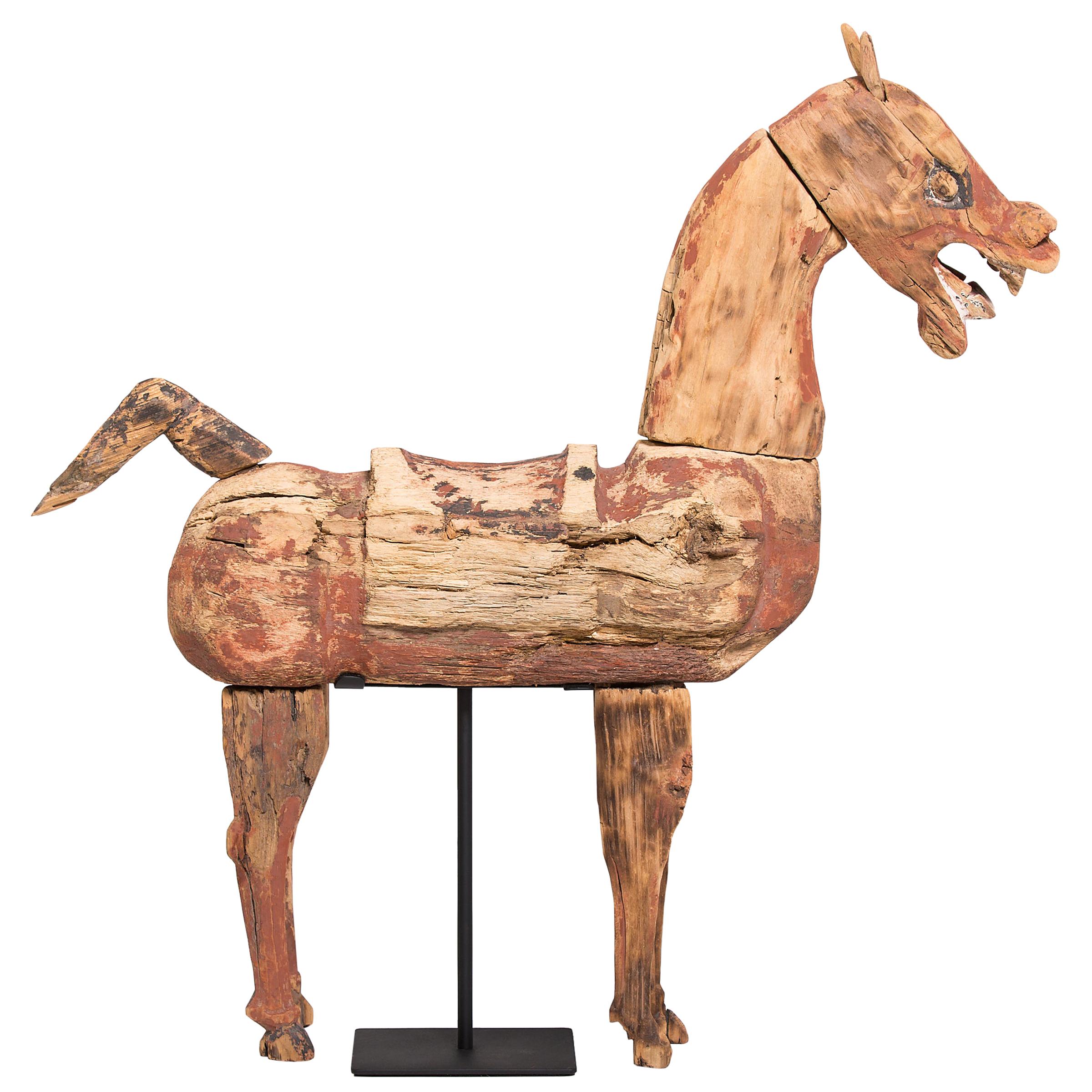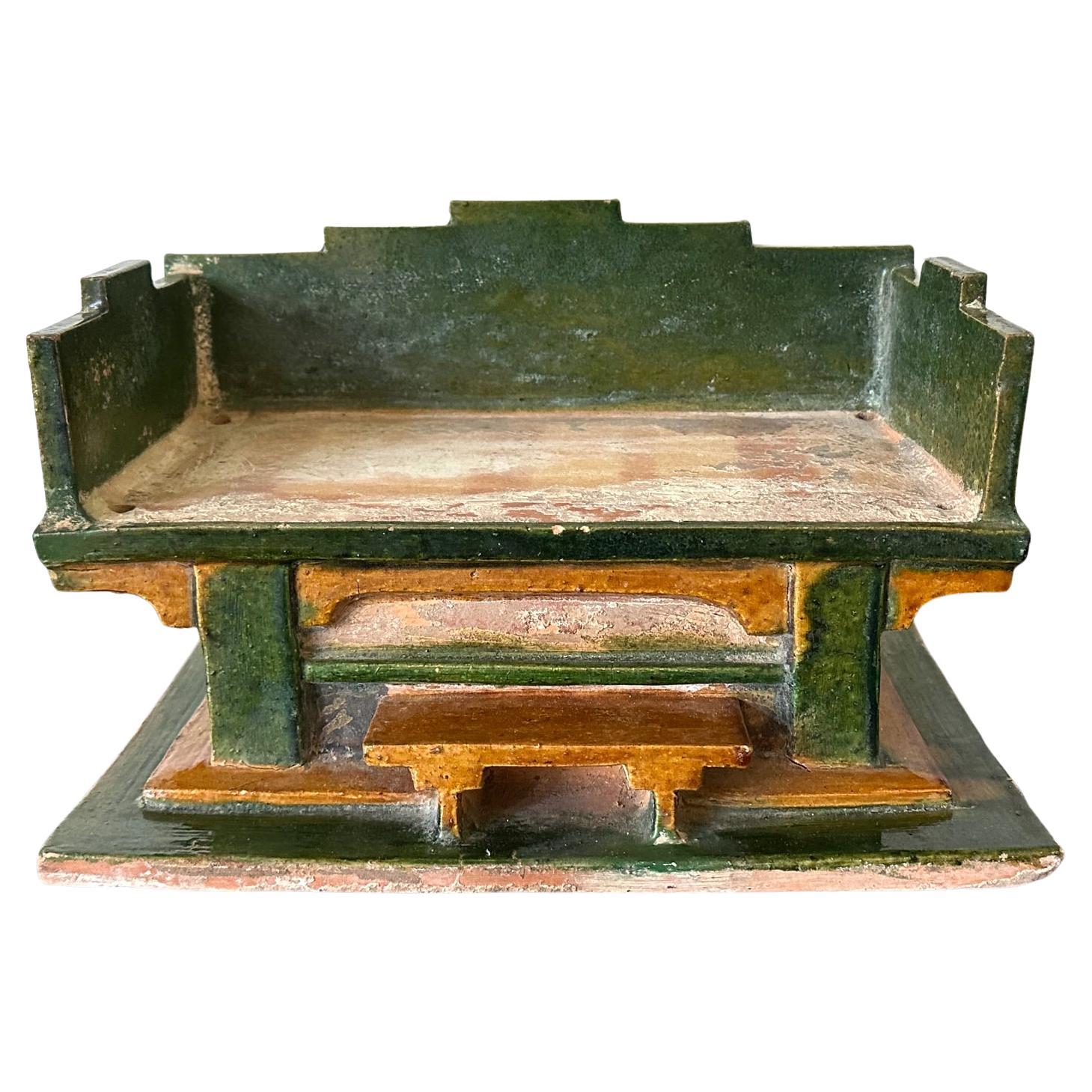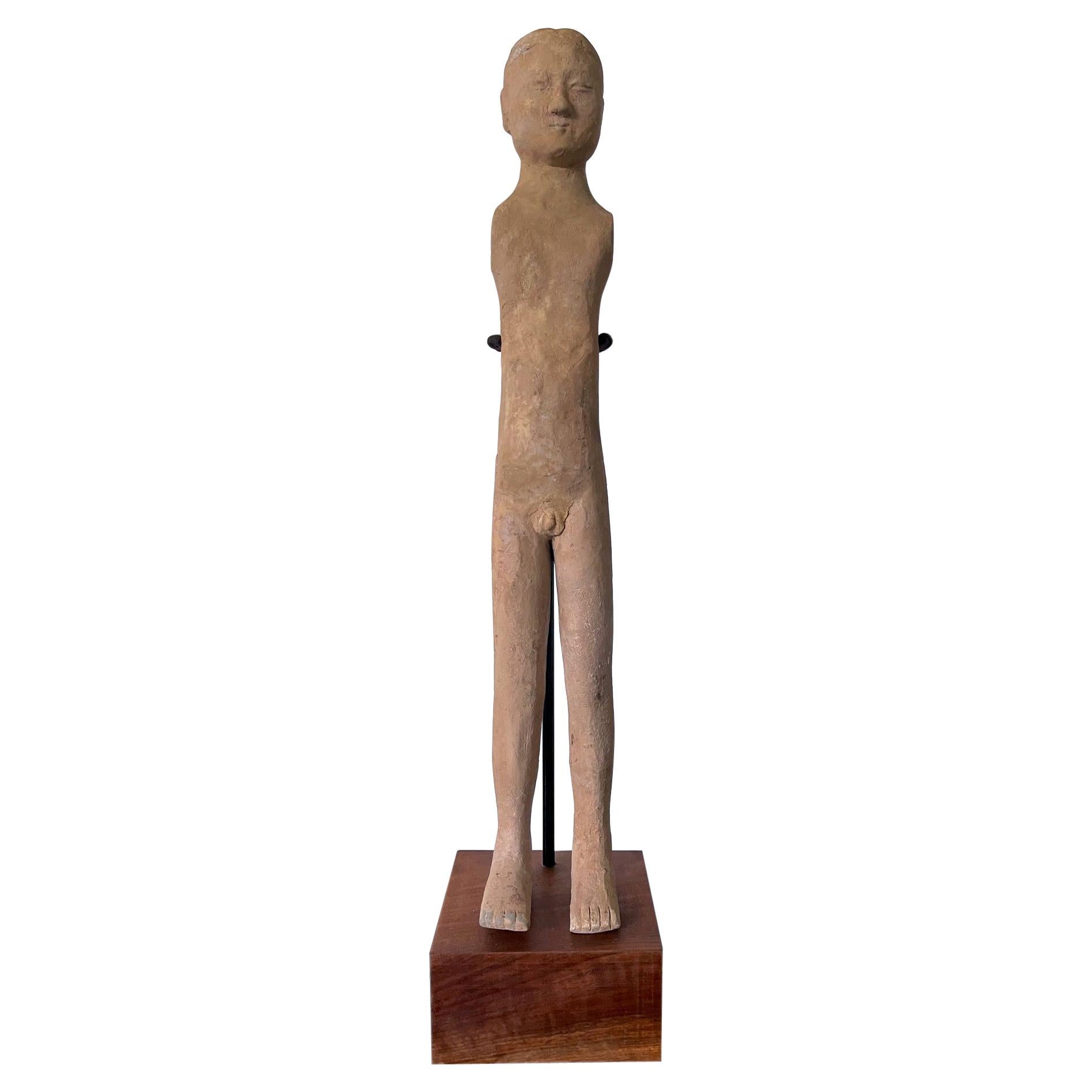Items Similar to Antique Ming Dynasty Chinese Earthenware Horse Sculpture Míngqì Tomb Figure
Want more images or videos?
Request additional images or videos from the seller
1 of 10
Antique Ming Dynasty Chinese Earthenware Horse Sculpture Míngqì Tomb Figure
About the Item
A scarce 600 year old (approx) Chinese pottery Ming Dynasty (1368-1644) large glazed earthenware míngqì tomb figure, modeled as horse sculpture with saddle, stirrups, and integral base.
This hand-crafted Chinese earthenware horse is a type of centuries-old burial figurine known as míngqì. Depicting the pleasures of daily life, míngqì figurines were offerings to one's spirit to ensure comfort and special treatment in the afterlife. Míngqì often take the shape of figural attendant servants, dancers, musicians, warriors, concubines, and livestock. Although míngqì have been constructed of wood and terracotta / clay earthenware pottery since as early as the Han dynasty, intact forms are quite rare, especially of this large size and proportion, making this horse burial figure an extraordinary find!
Dimensions: (approx)
15" Tall, 12" Wide, 5" Deep
A superb museum quality example, the horse statue is in excellent original antique condition, with beautifully aged warm patina, minor rubbing and small fissure to back of body, minimal wear commensurate with age, use, handling, and exposure.
Provenance / Acquisition:
Acquired from the highly reputable auction house, J. Garrett Auctioneers, Dallas, Texas. Turtle Creek & Dallas Estates catalog. Garrett was pleased to present the contents of a fine Turtle Creek estate, as well as selections from the collection of beloved Dallasite, Jane Akin Brasch. Property seized from JMJ Development, the Dallas development firm controlled by Tim Barton and set to become the first Mandarin Oriental hotel in Dallas will also be offered in this two-day auction. Highlights include period antiques, fine art, notable sculpture, sterling silver, fine jewelry and designer handbags
- Dimensions:Height: 15 in (38.1 cm)Width: 12 in (30.48 cm)Depth: 5 in (12.7 cm)
- Style:Ming (Of the Period)
- Materials and Techniques:
- Place of Origin:
- Period:
- Date of Manufacture:1368-1644 A.D.
- Condition:Wear consistent with age and use. Minor fading. A superb museum quality example, the horse statue is in excellent original antique condition, with beautifully aged warm patina, minor rubbing and small fissure to back of body, minimal wear commensurate with age, use, handling, and exposure.
- Seller Location:Forney, TX
- Reference Number:1stDibs: LU5977239594502
About the Seller
4.7
Platinum Seller
These expertly vetted sellers are 1stDibs' most experienced sellers and are rated highest by our customers.
Established in 2013
1stDibs seller since 2021
205 sales on 1stDibs
Typical response time: <1 hour
- ShippingRetrieving quote...Ships From: Forney, TX
- Return PolicyA return for this item may be initiated within 7 days of delivery.
More From This SellerView All
- Chinese Ming Dynasty Antique Sancai Glazed Attendants Tomb Figure PairLocated in Forney, TXA pair of large antique Chinese polychrome ceramic attendants, Ming Dynasty (1368-1644). Outstanding 500+ year old Sancai glazed earthenware pottery tomb figures, exceptionally executed figural form, exquisitely detailed, one holding a teapot, the other holding a charger, rising on rare sculptural plinth...Category
Antique 15th Century and Earlier Chinese Ming Sculptures and Carvings
MaterialsCeramic, Earthenware
- Chinese Ming Dynasty Architectural Terracotta Roof Tile Figure Qilin Foo Dog prLocated in Forney, TXA remarkable pair of large Ming Dynasty (1368-1644) earthenware Imperial roof decorations - ornamental architectural terracotta roof tile beasts. 15th/16th century or earlier, Northern China, most likely Forbidden City, Dongcheng District, Beijing, figural pottery modeled as mythical qilin (foo dog / guardian lion), the crouching beast with legs back and flaming body depicted ready to pounce. Retaining partial remnants of the red wax export seal, indicating they are authentic and were legally exported out of the country. Dimensions: (approx) Largest: 18" Tall, 19" Wide, 8" Deep History: Chinese roof tiles have been a part of Chinese architecture for over 2,000 years. These unique and beautifully crafted tiles have become an integral part of traditional Chinese culture, and have gained international recognition for their beauty and cultural significance. In this article, we will explore the different types of Chinese roof tiles, their construction, cultural significance, preservation and restoration techniques, and modern uses. Chinese imperial roof decorations or roof charms or roof-figures (Chinese: 檐獸/檐兽; pinyin: yán shòu) or "walking beasts" (Chinese: 走獸/走兽; pinyin: zǒu shòu) or "crouching beasts" (Chinese: 蹲獸/蹲兽; pinyin: Dūn shòu) were statutes placed along the ridge line of official buildings of the Chinese empire. Only official buildings (palaces, government buildings, and some temples) were permitted to use such roof decorations. Occasionally arranged in an outward marching procession with various different examples, the number and type indicating the importance of the duties performed within the building or within the courtyard protected by a gate. With a maximum number of nine, the mythical beast was one of the highest in rank, thus modeled set to pounce upon the man and lower ranking creatures, ready to devour them should they stray from performing their duties with faithfulness and rectitude The Design and Construction of Chinese Roofs: The roof design is an important aspect of Chinese architecture, with each component of the roof playing a specific role. Chinese roof tiles fit into the overall design of the roof and are placed on top of wooden supports called purlins. The interlocking system of Chinese roof tiles ensures that they stay in place and prevent leaks. Ridge tiles...Category
Antique 16th Century Chinese Ming Sculptures and Carvings
MaterialsEarthenware, Terracotta
- Qing Dynasty Chinese Sancai Temple Guardian FigureLocated in Forney, TXA large antique Chinese glazed Sancai pottery temple guardian figure, designed to ward off evil spirits and protect the owners tumb. Hand crafted, excep...Category
Antique 18th Century Sculptures and Carvings
MaterialsPottery
- Qing Dynasty Chinese Carved Green Jade Chilong Dragon SculptureLocated in Forney, TXA magnificent Chinese carved spinach green jade chilong dragon sculpture, resting on fitted hardwood stand. Rich deep bright green color with molten shades of lighter pale green, exceptionally carved, with intricate detail throughout. The mythical beast lying ready on all four, head raised, mouth ajar with teeth exposed, wings by its side, spiral scroll incised on hind legs. Provenance: Estate of Ali A. Abssi (1934-2020) and Florence Hall Abssi (1919-2014), founders of the Ishtar Gate...Category
Antique 19th Century Sculptures and Carvings
MaterialsJade
- Antique Korean Carved Polychrome Wooden Buddhist Figure SculptureLocated in Forney, TXBring a touch of peaceful tranquil serenity and help ward off sickness and negative energy with this large Joseon dynasty (1392–1910) antique Asian hand carved and painted wood Buddh...Category
Antique 19th Century Korean Folk Art Sculptures and Carvings
MaterialsWood
- Monumental Antique Chinese Ancestral ShrineLocated in Forney, TXA magnificent Qing Dynasty (1636-1912) architectural ancestral shrine. 19th century, China, exceptionally executed in traditional ancient Chinese architecture timber-frame temple h...Category
Antique 19th Century Chinese Qing Sculptures and Carvings
MaterialsWood
You May Also Like
- Chinese Ming Celestial Mingqi Horse FigureLocated in Chicago, ILThis hand carved Chinese wooden horse is a type of centuries-old burial figurine known as míngqì. Depicting the pleasures of daily life, míngqì f...Category
Antique 16th Century Chinese Ming Sculptures and Carvings
MaterialsWood
- Chinese Ming Dynasty Tomb Funeral Pottery Bed ModelLocated in Atlanta, GAA Chinese stoneware day bed model circa Ming dynasty (15th-17th century). The miniature models were traditionally made as burial offering objects. Pottery models of daily life necess...Category
Antique 16th Century Chinese Ming Ceramics
MaterialsStoneware
- Chinese Ming Dynasty Tomb Funeral Pottery Bed ModelLocated in Atlanta, GAA Chinese stoneware day bed model circa Ming dynasty (15th-17th century). The miniature models were traditionally made as burial offering objects. Pottery models of daily life necess...Category
Antique 16th Century Chinese Ming Ceramics
MaterialsStoneware
- China Antique Pair "Spirit Path" Horse Sculptures, Ming Dynasty 500 Years OldLocated in South Burlington, VTChina, a monumental pair (2) of 500 year old lime stone “Spirit Path” Equine horse head sculptures. Ming dynasty, (1368-1644 CE). A pair of near life size and robust head sections with fine, wavy combed manes, well defined mouths, ears, nostrils, and ornamental bridles, all carved in a medium to dark gray limestone with considerable weathering to surfaces. The smaller head with a later inscription on bottom and signed “Zhuang”. Formerly exhibited “Treasures from Asia”, Shelburne Vermont, Shelburne Art Center, 2006. Originally found in the vicinity of the village of Chuan near Luoyang City, Henan Provance, China. Each mounted on a custom iron display stand. Dimensions: A the smaller 32.5cm, 13” high and 62.5cm, 25” in length and with display stand, 60cm, 24” high; b the larger 37.5cm, 15” high and 67.5cm, 27” in length and with display stand 65cm, 26” high. Please view additional photographs from our Chinese antiquities catalog 35 Years Collecting 35 Treasures, page 60. History: Placing stone animals and human figures along spirit paths in front of important tombs can be traced back at least to the Qin Dynasty (221-206 BCE), some two thousand years ago. In ancient times, stone animals and human figures placed before imperial tombs symbolized royal power and privilege in addition to decorative functions. Life size “spirit path” stone horse sculptures are known and can be viewed from Ming dynasty tombs including thirteen imperial tombs of the Ming Dynasty scattered over an area of forty square kilometers in Changping District to the northwest of Beijing. The first Ming tomb...Category
Antique 16th Century Chinese Ming Statues
MaterialsLimestone
- Pair of Chinese Ming Dynasty Tomb Funeral Pottery Chair ModelsLocated in Atlanta, GAA pair of Chinese stoneware horseshoe cross chairs circa Ming dynasty (15th-17th century). The miniature models were traditionally made as burial offeri...Category
Antique 16th Century Chinese Ming Ceramics
MaterialsStoneware
- Chinese Stoneware Tomb Figure Han DynastyLocated in Atlanta, GAA Chinese molded stoneware figure on a custom display stand likely from Han Dynasty (202BC-220AD). These pottery figures were used as part of tomb accouterment for the burial practic...Category
Antique 15th Century and Earlier Chinese Archaistic Ceramics
MaterialsStoneware
Recently Viewed
View AllMore Ways To Browse
Used Sterling Silver Fine Jewellery
Wood Figure And Sculpture
Antique Auctions
Auction Antique
Antique Catalog
Chinese Wood Sculpture
Wood Sculpture China
Horse Figure
Antique Sculptures Houses
Chinese Horse
Horse China
Antique Earthenware Pottery
Horse And Model
Antique Horse Sculptures
Antique Horse Sculpture
Large Antique Horse
Early Tall Sculpture
Tall Figure Sculpture





